Wira built his first guesthouse in the middle of the Bali rice terraces.
The floor-to-ceiling windows are stacked up against the sky; the thatched straw roof blending seamlessly into the greens and browns of long grass on the terrace steps.
Wira’s family has owned this land for generations, using these fields for growing rice and cultivating chilli plants. Now there’s another business plan in the works: using the natural beauty of their surroundings to harness the tourist market.
Wira already uses Airbnb to rent out a few rooms in his family compound to travellers who pass through his village, but he’s also putting the finishing touches to a private guesthouse surrounded by nothing but rice fields as far as the eye can see.
And by a stroke of luck, my boyfriend and I are the first guests to ever stay here.
Of course, we didn’t know any of this when we first arrived.
We’d left Ubud that morning and driven to the Setia Darma House of Mask and Puppets — a fascinating museum with virtually no visitors, which delayed us for hours because I loved the place so much. By the time we found Wira’s front door on a dusty country lane just outside of Sidemen, it was 9pm and pitch black.
After a beer on Wira’s patio, looking out into the velvety darkness and imagining the view we’d see the next day, a friend of Wira’s jumped onto his scooter and led our car out of the village and through the rice paddies. The darkness morphed and changed as we moved towards something illuminated, which gradually took on the shape of a two-storey building.
Although I didn’t quite believe it, this was our private guesthouse.
Why do tourists love the Bali rice terraces so much?
When I was researching where to go in Bali, I’d immediately been turned off by the idea of visiting the over-touristed places.
Apart from Ubud, which I knew would be dense with foreign visitors, I was eager to spend my time exploring peaceful Balinese landscapes. But my research repeatedly pointed to places like the Jatiluwih rice terraces in West Bali and the Tegallalang terraces close to Ubud.
Both locations are absolutely gorgeous – and they both welcome crowds of tourists every day. Dotted throughout the valleys are giant swings, zip lines and ‘I Love Bali’ cutouts to pose beside, as well as a series of designated entry points and admissions fees.
The Bali rice terraces are a prime tourist hotspot, so the local Balinese have, rightly enough, decided to capitalise. A rice field tourism industry has sprung up, with everything from guided tours and cycling routes to nearby hotels and roadside stalls all pandering to the interest in these stunning locations.
The articles I read about the rice terraces in Tegallalang and Jatiluwih told stories of tourists paying farmers for the privilege of borrowing their pointed straw hats for posed photos, and people dutifully lining up to get ‘the’ shot of sunrise gently breaking over the fields.
Tempting for some – particularly those who come to Bali for its Instagram-worthy photos – but this kind of rice field experience wasn’t really my cup of tea.
Yet I was still fascinated with the idea of visiting the rice terraces and finding the oasis of calm which I knew existed there.
So we trawled through Airbnb for listings, and that’s when we found Wira’s place: just outside Klungah village, one of the many villages in the area of Sidemen, East Bali. This region is rural, tranquil and undoubtedly the more peaceful alternative to Jatiluwih and Tegallalang.
But I had no idea quite how special this place was in its own right until the next morning.
Sunrise in the Bali rice terraces
The first I knew of sunrise was my boyfriend getting out of bed. I groaned and turned towards my phone, the alarm blaring through my ear-plugged ears.
As my bleary mind adjusted to morning, I noticed the light filtering through the long white curtains shading the all-glass walls. Wira had told us that sunrise was well worth the early wakeup call, but that didn’t bring me to consciousness any faster.
Camera, check. GoPro, check. Phone, check.
I headed towards the steep stairs, but wasn’t awake enough to properly carry all the necessary devices down them. I was halfway down when I realised I didn’t have my glasses on my face: the most crucial part of actually being able to see.
It took a while to get myself ready. But when I finally opened the door and stepped outside, the view laid out before me was extraordinary.
Orange light fell in slim shards across the water, laying itself against the endless edges of the rice paddies. Green palm tree fronds criss-crossed the view, repeated reflections dotted with tiny green spikes of sprouting rice plants.
And further in the distance, layers of mist rose above the silhouetted tree lines on the horizon.
As someone who finds it hard to feel awake before 8am, this felt like the most secret time of day. But the more I stood there gazing at the view, the more I realised how my daily routine pales in comparison to that of a farmer living in Asia.
In Bali, early morning is prime working time. Before the sun had risen fully, bringing with it the heat of the day, there were dozens of figures moving amongst the rice fields. Farmers carried scythes and burlap sacks, threading their way through the paddies. Scooters and cars drove up and down the narrow curving road, with groups of clamouring children sat in the back, on their way to school.
We stood on the guesthouse porch as a man approached the paddy directly below us and began to lift small rice plants out of a sack, pressing them gently into the water. Another morning’s planting.
As the light grew brighter, the haze of early morning eventually dissolved into bright sunshine, the pause in time over as quickly as it began.
And with it, the heat grew immediately stronger.
Exploring the rice fields in the Balinese heat
On the ground floor of the guesthouse I showered under cold water, grateful for the temperature to bring me out of my sleepy stupor.
Then we walked through the rice paddies to our parked car (which looked rather tiny amongst the huge palms) and drove over to Wira’s house for breakfast.
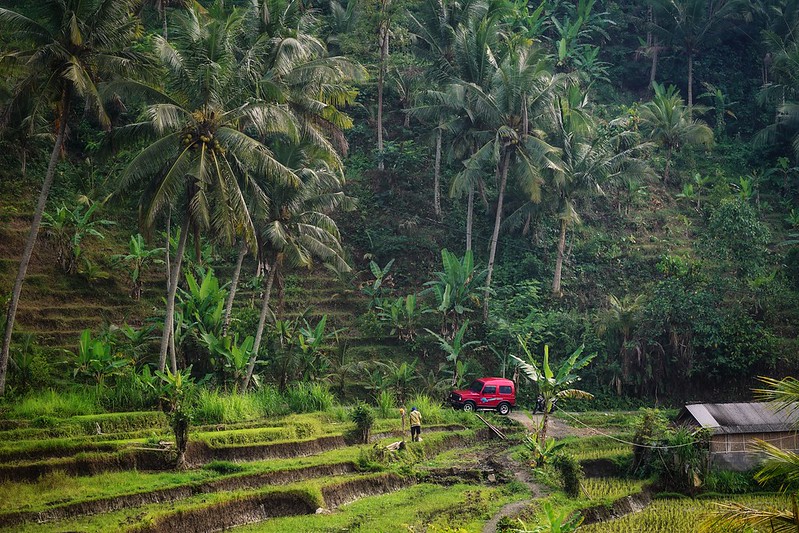
Like most Balinese, Wira’s family lives in a traditional family compound. The inhabited buildings are all built in a square around an open pavilion area, and because Wira’s home is built into a hillside it also features another stunning view across the rice fields below.
We ate our breakfast of banana pancakes and condensed milk, watching flocks of birds soar over the paddies in front of us. By the time we’d moved onto omelettes, Wira had brought his friend over to meet us.
“This is Wayan,” he said. “He will take you walking in the village.”
Wayan led us out of the village and straight upwards into the terraces in the already baking 8am sun.
Our destination? The water system at the top of the farmed terraces.
How exactly do they irrigate the Bali rice terraces?
The planting, irrigation, cultivation and harvesting of rice is a huge focus in Bali. Traditionally the crop is viewed as a gift from the gods and it’s also a staple of the Balinese diet – which explains why large swathes of the island’s land is dedicated to growing rice.
The Balinese use a thousand-year-old water irrigation system known as subak, which employs various weirs, sluices, dams and canals to collectively manage water distribution from a single water source. It’s also the name for the social system which maintains irrigation: every rice farmer is a member of a subak, and the subaks are all connected to water temples located at mountains and lakes. There are water ceremonies at these temples every 105 days, which correspond with the 105-day rice growing season and also indicate when the canal sluices are opened and closed.
In fact, the subak system is so highly regarded that, in 2012, Bali’s rice terraces throughout the island were deemed a UNESCO World Heritage Site.
From up high it was easier to see how the system operated. As we stepped over a sluice gate, I could imagine the ritual every three months; strong hands deftly turning the huge screw and slowing the flow of water for another season.
The view of the terraces below displayed rice in all its stages of growth: the bright green of germinating seeds, the tall rice ready to be harvested, plumes of smoke from burning off the dry grasses, and the empty fields waiting for the next planting.
Watching Balinese village life go by
By 10am we were back at Wira’s family compound: the heat was already too intense for much activity, and it only grew hotter .We sat in the shade eating nasi goreng until we finally admitted defeat and walked back along the thin road towards our AirBnb, while curious children stared at us from the handlebars of their parents’ scooters.
Back inside the house, I crawled up the steep steps with every intention of lying down to read. I realised a half hour later that I’d either fallen asleep or passed out due to the heat, so I headed outside to the shady patio with a pillow, a cold beer, and a shirt soaked in cold water as a last-ditch attempt to stave off heatstroke.
For the next few hours, we simply sat in the soporific afternoon heat and watched Balinese village life slowly unfold.
It’s not often that I stop to watch the world go by, but in Bali it’s all-encompassing.
There were men carrying bundles of dry grass, sacks of coconuts and full-on trees on their scooters. Children washing in the narrow ribbons of water between the fields. There was a stunningly surreal moment when a phone recording of gamelan music boomed throughout the valley – only to be replaced by what was presumably the owner’s ringtone.
There were crowds of swallows swooping and diving over our heads. A huge snake slithering through the paddies right in front of us. A flock of ducks who waddled their way down the road toward a distant field, chivvied along by a farmer waving his arms (plus it turns out that ducks have a significant role in maintaining rice crops in Bali!).
Rural village life was everywhere – and it was utterly gorgeous.
Finding the non-touristy side of Bali
In recent years, Bali has been discussed among my traveller friends with a shake of the head and the prevailing opinion that it’s become much too touristy. So I hadn’t been certain whether I’d find the calm, relaxing, effortlessly tranquil side of the island I’d hoped for.
Luckily, it seems there’s plenty of traditional life on this Indonesian island. You just need to make a bit of effort to search it out.
When we packed up our bags the next morning and said our goodbyes to Wira, he told us how excited he was to welcome more visitors to this part of Bali he calls home. He’s not too starry-eyed about filling his local rice terraces with eager tourists, though: the guesthouse he’s built here will be the only concrete construction to sit in the fields, and he also plans to donate the income from his rice terrace house to the village.
That’s because preserving this area is hugely important to him. For us, it also meant that choosing to stay in Wira’s rice terraces allowed us to help support the sustainable, eco-friendly side of Bali’s tourism.
And it’s a great deal, too: who would have thought you could find this experience in Bali for just £16 a night?!
Do you want to stay at Wira’s rice terrace guesthouse?
Sign up here and you’ll get free credit from me on your first Airbnb stay!

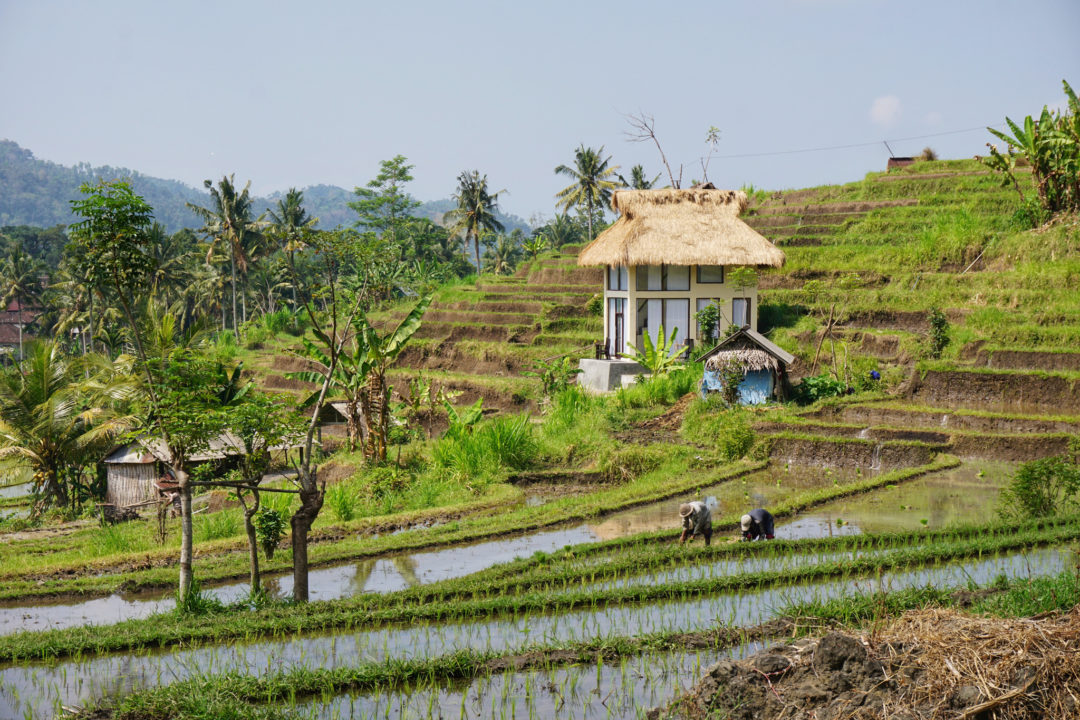


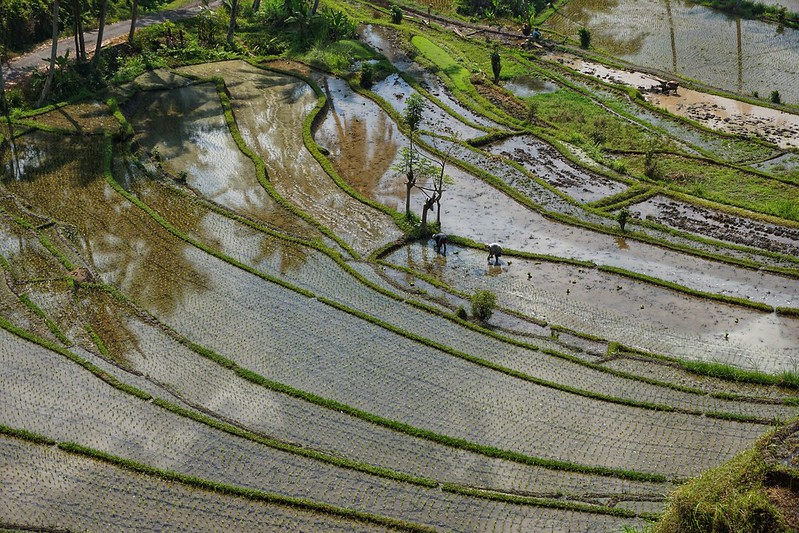
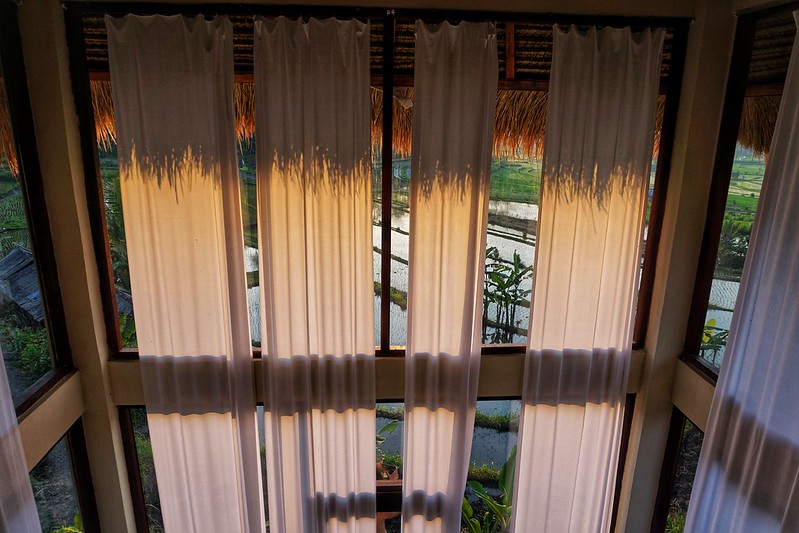

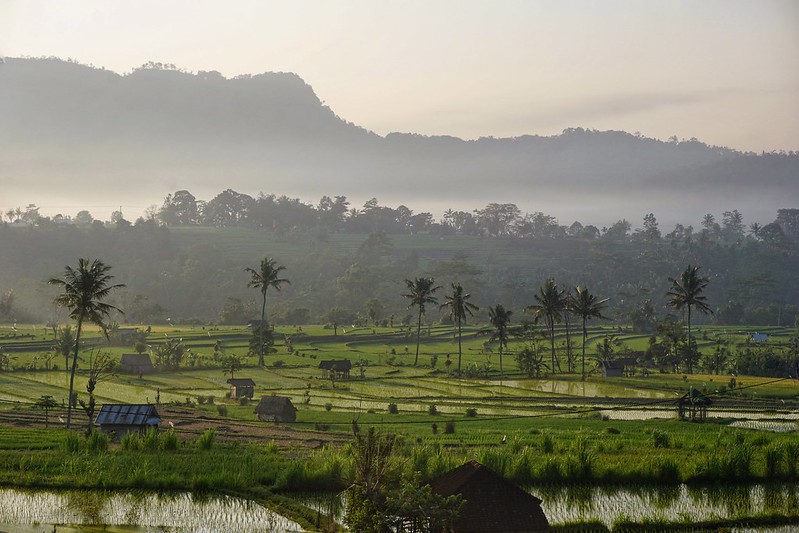
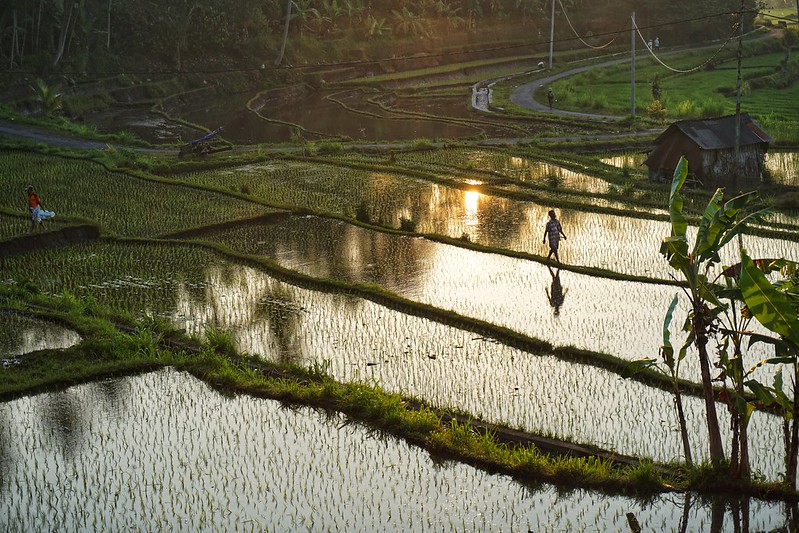

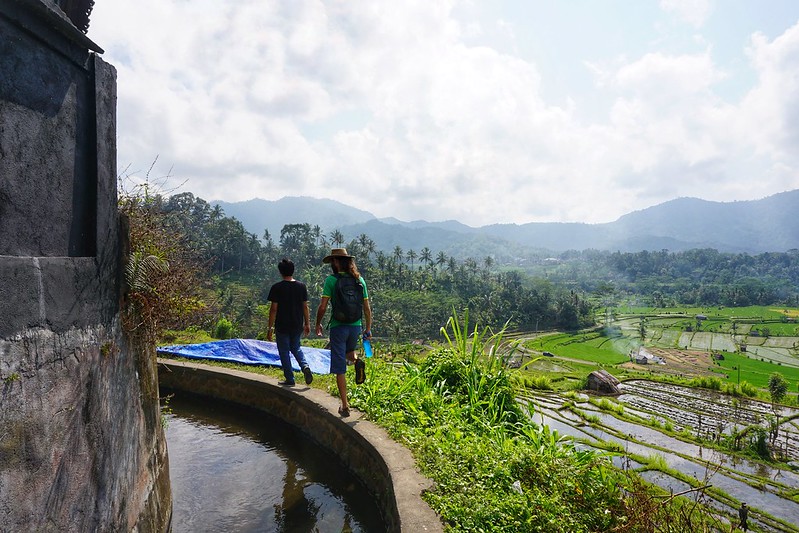
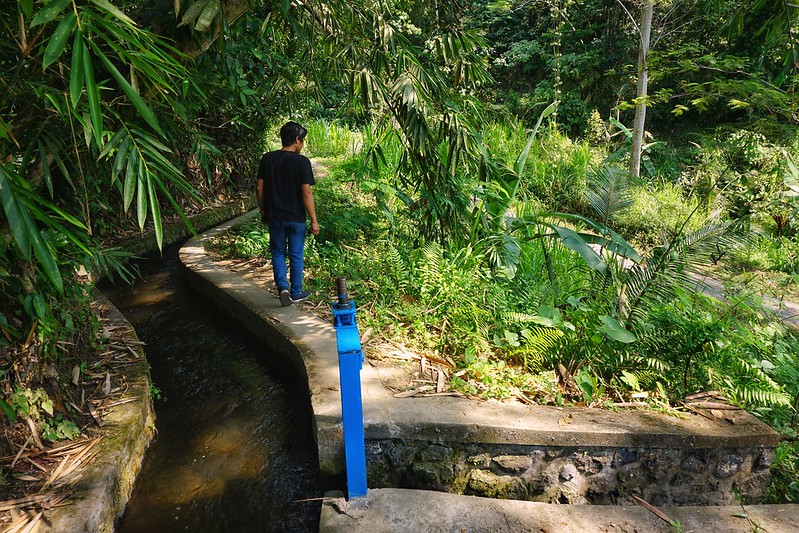
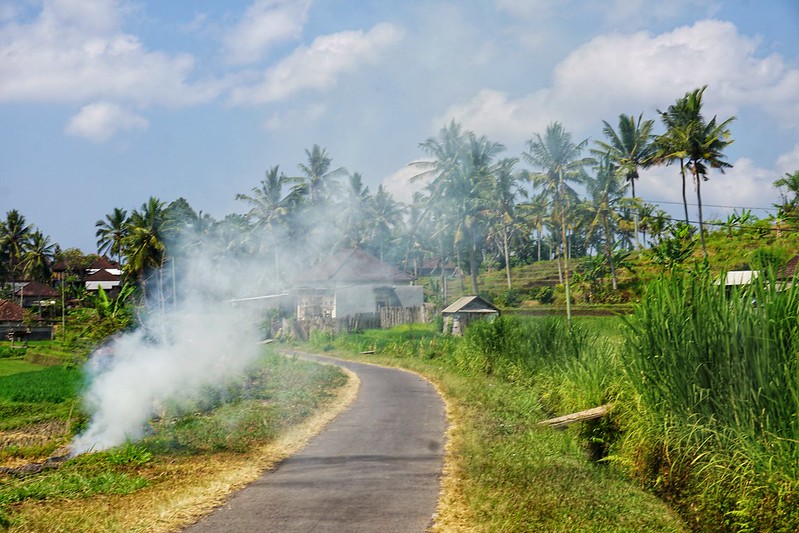
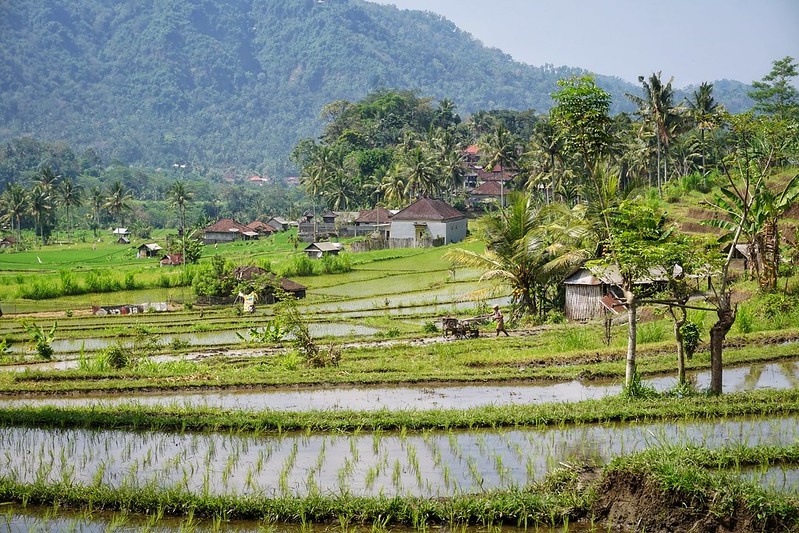

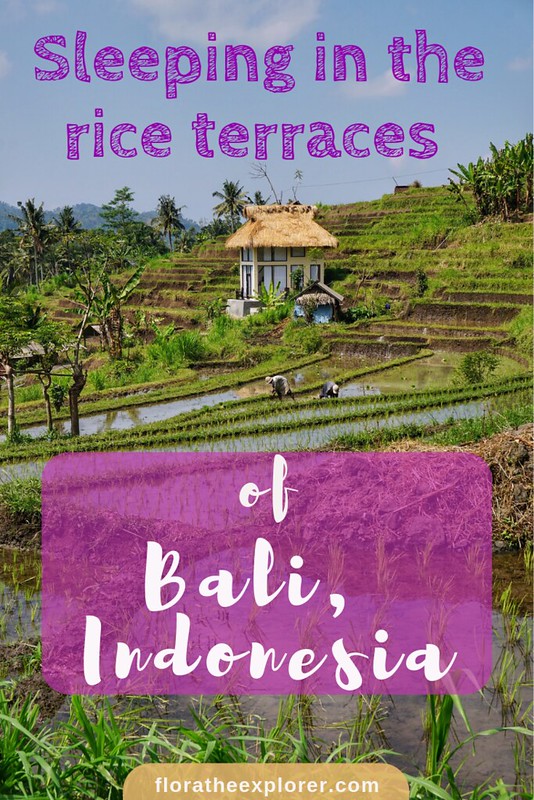
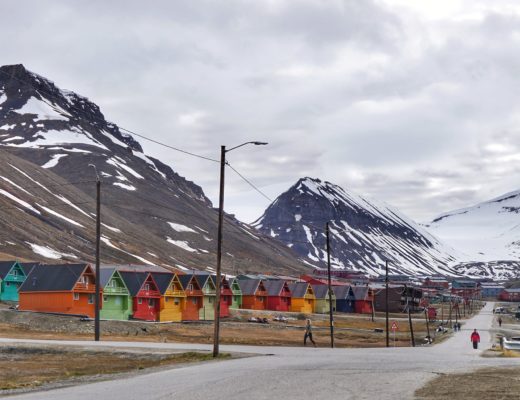
13 Comments
Ramit
December 15, 2018 at 7:11 amGreat post! Loved reading it throughout. Bali has a number of beautiful destination and is very good to experience a joyful vacation. Lovely pictures… Thank you so much for sharing this post.
Flora
December 17, 2018 at 11:29 amThanks for reading, Ramit! I’m glad you enjoyed it 🙂
tamsing
December 15, 2018 at 3:47 pmI enjoyed your post. A good balance of attractive photos, sound writing and not too long Thanks
Flora
December 17, 2018 at 11:30 amThanks so much Tamsing!
Geeta
December 17, 2018 at 7:29 amBali is one of my favorite place to visit. It has a good place to enjoy the moment. Thanks for valuable sharing about Bali. It’s give me an idea for my next trip. Loved you pictures and post.
Flora
December 17, 2018 at 11:30 amThanks Geeta! I hope you enjoy your eventual trip to Bali 🙂
Ian McCurrach
December 17, 2018 at 10:45 pmAnother great travel feature/blog darling Flora and well done you! You conjure up such beautiful images with your highly creative and descriptive writing and your pics are nothing short of beautiful! Ian XX
Flora
January 24, 2019 at 11:19 amAww thanks so much Ian!
C. Randen
December 23, 2018 at 8:48 amI have never been to Bali, but it looks amazing! Thank you for the information, I am going to plan a trip there in the very near future!
Flora
January 24, 2019 at 11:46 amI hope you make it to Bali and have a fantastic time, C!
Julia
January 8, 2019 at 5:52 pmHi Flora!
Three things:
1. I have read every post you’ve written about South America (and a bunch of others too) and I feel a lot more confident about traveling there solo now. Thank you!
2. You’ve probably answered this before but I can’t seem to find a post about it; what camera do you use for your travel photos? They look great!
3. You seem like such a funny, brave and sensible person. So if you ever come to Sweden I want to have coffee with you, hear about your travels and show you around. And I have a spare room if you need it!
Greetings from Julia in Lund 🙂
Flora
January 24, 2019 at 12:21 pmAww Julia, this is so sweet! I’m really glad you’ve found some bolstering info and inspiration for solo travel in South America. I honestly can’t recommend it enough! As for my camera – it depends which articles you’re reading but I’ve been using a Sony A6000 mirrorless camera for the last three or four years which I absolutely love. In South America I was using a little point & shoot though (I think it was a Canon Powershot? Not a particularly high tech camera but I loved it!). As for coming to Sweden – I would absolutely love to meet up when I finally make it there! A lovely friend of mine who I met in India is actually from Lund too (although she lives in Stockholm now)!
Ras Bahadur Rai
June 18, 2023 at 8:45 amYour travel blog has quickly become my go-to source for wanderlust inspiration! The stunning visuals and captivating narratives transport me to distant lands, sparking a desire to explore and experience the world’s beauty. Thank you for sharing your incredible adventures!